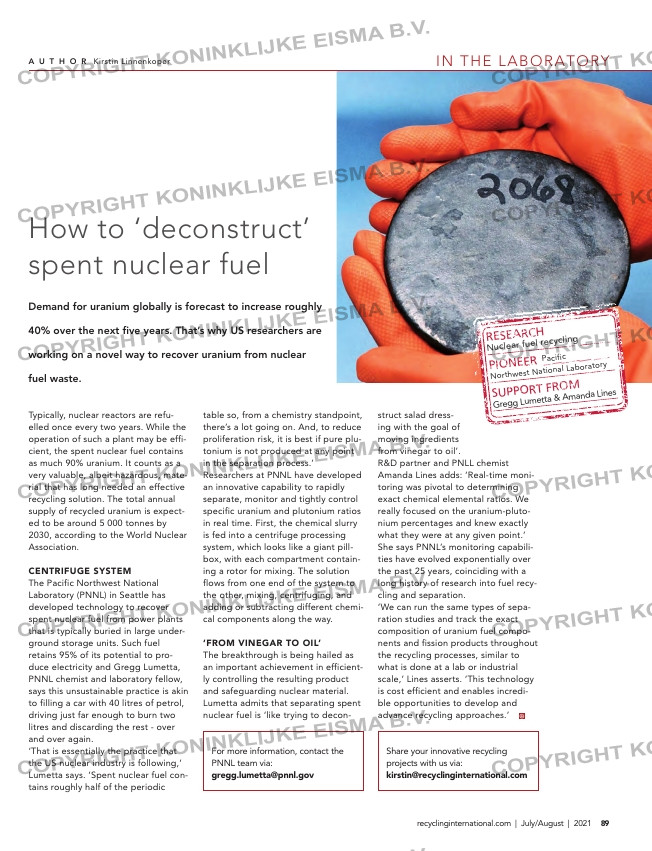In the Laboratory
89recyclinginternational.com | July/August | 2021
how to ‘deconstruct’
spent nuclear fuel
Demand for uranium globally is forecast to increase roughly
40% over the next five years. That’s why US researchers are
working on a novel way to recover uranium from nuclear
fuel waste.
Typically, nuclear reactors are refu-
elled once every two years. While the
operation of such a plant may be effi-
cient, the spent nuclear fuel contains
as much 90% uranium. It counts as a
very valuable, albeit hazardous, mate-
rial that has long needed an effective
recycling solution. The total annual
supply of recycled uranium is expect-
ed to be around 5 000 tonnes by
2030, according to the World Nuclear
Association.
Centrifuge system
The Pacific Northwest National
Laboratory (PNNL) in Seattle has
developed technology to recover
spent nuclear fuel from power plants
that is typically buried in large under-
ground storage units. Such fuel
retains 95% of its potential to pro-
duce electricity and Gregg Lumetta,
PNNL chemist and laboratory fellow,
says this unsustainable practice is akin
to filling a car with 40 litres of petrol,
driving just far enough to burn two
litres and discarding the rest – over
and over again.
‘That is essentially the practice that
the US nuclear industry is following,’
Lumetta says. ‘Spent nuclear fuel con-
tains roughly half of the periodic
table so, from a chemistry standpoint,
there’s a lot going on. And, to reduce
proliferation risk, it is best if pure plu-
tonium is not produced at any point
in the separation process.’
Researchers at PNNL have developed
an innovative capability to rapidly
separate, monitor and tightly control
specific uranium and plutonium ratios
in real time. First, the chemical slurry
is fed into a centrifuge processing
system, which looks like a giant pill-
box, with each compartment contain-
ing a rotor for mixing. The solution
flows from one end of the system to
the other, mixing, centrifuging, and
adding or subtracting different chemi-
cal components along the way.
‘from vinegar to oil’
The breakthrough is being hailed as
an important achievement in efficient-
ly controlling the resulting product
and safeguarding nuclear material.
Lumetta admits that separating spent
nuclear fuel is ‘like trying to decon-
struct salad dress-
ing with the goal of
moving ingredients
from vinegar to oil’.
R&D partner and PNLL chemist
Amanda Lines adds: ‘Real-time moni-
toring was pivotal to determining
exact chemical elemental ratios. We
really focused on the uranium-pluto-
nium percentages and knew exactly
what they were at any given point.’
She says PNNL’s monitoring capabili-
ties have evolved exponentially over
the past 25 years, coinciding with a
long history of research into fuel recy-
cling and separation.
‘We can run the same types of sepa-
ration studies and track the exact
composition of uranium fuel compo-
nents and fission products throughout
the recycling processes, similar to
what is done at a lab or industrial
scale,’ Lines asserts. ‘This technology
is cost efficient and enables incredi-
ble opportunities to develop and
advance recycling approaches.’
For more information, contact the
PNNL team via:
[email protected]
Share your innovative recycling
projects with us via:
[email protected]
a U T h o r Kirstin Linnenkoper
RESEARCH
PIONEER __
_________
SUPPORT FR
OM
Nuclear fue
l recycling
Gregg Lume
tta & Amand
a Lines
Pacific
Northwest
National La
boratory
89_inthelab.indd 89 06-07-21 14:41




